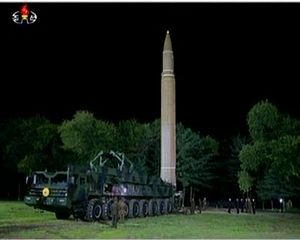North Korea’s most recently tested Hwasong-14/KN20 intercontinental ballistic missile (ICBM) on July 28, 2017, featured a new addition to the missile’s second stage, U.S. government sources with knowledge of North Korea’s weapons programs told The Diplomat.
The missile’s second stage featured yaw maneuvering motors to help stabilize it in flight, a source told The Diplomat, adding that the technology had previously been observed in the upper stages of North Korea’s Unha series of satellite launch vehicles.
North Korea’s state-run Korean Central News Agency (KCNA), in a release on the July 28 ICBM test, noted that the test “confirmed the performing features of motors whose number has increased to guarantee the maximum range in the active-flight stage as well as the accuracy and reliability of the improved guidance and stability system.”
It’s unclear if the statement referred to the addition of yaw maneuvering motors alone or if the missile’s second stage featured other substantive engineering changes, including the potential addition of extra engines.
A missile’s yaw refers to its rotation around a vertical axis, which can either be influenced through the addition of control surfaces, which would likely be externally observable, or through additional motors. Based on North Korea’s released imagery, no new control surfaces are visible on the missile’s second stage, which appears identical to the second stage seen on the July 4 missile.
North Korea’s Hwasong-14 ICBM is suspected to have used a two-vernier configuration for the second stage in the July 4 test and some experts anticipate that the “increased” number of motors referenced by KCNA could hint at a different motor configuration for the second stage. Vernier engines are used to steer the missile in flight.
Without appropriate compensation for undesired yaw maneuvers at high altitudes, the ICBM could see catastrophic failure. The addition of a yaw maneuvering motor could suggest the addition of two additional steering verniers, but this remains unconfirmed.
As The Diplomat first reported, the July 28 launch demonstrated considerably longer-range capability, featuring an apogee of approximately 3,700 kilometers, almost 900 kilometers higher than the July 4 apogee. The missile additionally flew to a range of nearly 1,000 kilometers.
It’s unclear if North Korea achieved this performance by using a different second stage motor configuration or by simply increasing the burn time for its engines.
Long-range ballistic missiles like the Hwasong-14 actively burn fuel to gain altitude, but can also benefit from momentum once airborne past a certain altitude to gain additional height. The missiles do not need to burn their engines for the entire duration of their ascent to the eventual apogee.
At the July 4 test, the missile’s first stage exhibited a burn time — or time that the engine was actively exhausting fuel — of 145 seconds. The second stage in that same test burned for 233 seconds, according to a source who spoke to The Diplomat.
Moreover, a source confirmed to The Diplomat that the July 4 Hwasong-14’s first stage reached an apogee of 585 kilometers. The July 28 Hwasong-14 test, meanwhile, saw its first stage reach a higher apogee of 703 kilometers.
Russia’s Continued ICBM Denial
The July 28 Hwasong-14 launch’s first stage apogee corresponds closely to Russia’s divergent intelligence assessment of that launch and falls within a similar margin of error as Russia’s assessment of the July 4 launch.
In both instances, Moscow, despite overwhelming evidence to the contrary from both North Korea and the United States, denied that Pyongyang tested an intercontinental-range ballistic missile, claiming instead that Pyongyang tested a medium-range ballistic missile.
After the July 4 test, Russia claimed that the missile exhibited an apogee of 535 kilometers and a range of 510 kilometers, putting its performance in the range of a medium-range ballistic missile (MRBM) like North Korea’s Pukkuksong-2. The Russian apogee claim was 50 kilometers off from the United States’ measurement of 585 kilometers for the first stage apogee.
Similarly, the United States’ assessment of an apogee of 703 kilometers for the first stage apogee in the July 28 test is close to Russia’s assessed apogee for missile test, which was 681 kilometers.
Between the two tests, it appears that Russia’s ultra high frequency (UHF) early warning radar systems — claimed to have been a Voronezh radar site at Irkutsk — were able to imprecisely detect the North Korean ICBM’s first stage, but completely failed to detect the missile’s second stage.
Given the relatively large wavelength of UHF radars such as Russia’s Voronezh systems, which are primarily designed to detect incoming U.S. ICBMs, it isn’t implausible that the Russian platforms were simply incapable of detecting the comparatively smaller North Korean Hwasong-14’s second stage. (Other phenomena, such as radar refraction over the curvature of the earth, can affect the effectiveness of these radar systems.)
In the case of the July 4 launch, somewhat curiously, Russian Foreign Minister Sergei Lavrov appeared to contradict earlier Russian claims that the missile was tracked by a Voronezh installation near Irkutsk.
Instead, Lavrov claimed in an interview on July 21 that Russia provided the U.S. Department of Defense with “objective data that we received from our radar units located just on the border with North Korea [emphasis added]” to substantiate its claim that North Korea launched a much shorter-range system.
No known Russian early warning radar sites exist along the country’s border with North Korea.

































